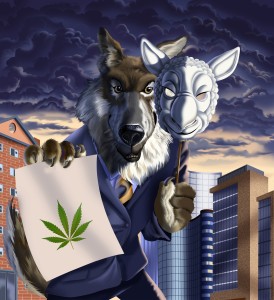
The following is a very poignant letter from an addictions treatment physician to the Pittsburgh Post-Gazette.
As this blog has warned before, today’s marijuana is different and far more potent than that on which this well-intentioned but wildly misjudged push for legalization was conceived.
Hybridized, genetically-modified marijuana is the product of an industry that is cloaking its push for full-blown commercialization of another addictive and harmful product in the guise of compassion and civil rights.
The product they are pushing is being proved to be dangerously strong and the cause of wasted potential, wasted productivity, and wasted lives.
The simple truth of commercialization following legalization:
Increased availability and decreased perception of harm drive youth use and lowers the age of initiation to drug use — the goal of an industry working to capture lifetime customers, despite known consequences for physical and mental health. Youth exposures double the risk of addiction.
Here is “Pot used to be pretty harmless, but its plenty dangerous today” as printed in the Pittsburg Post Gazette:
———-

Pot used to be pretty harmless, but it’s plenty dangerous today
It’s up to 10 times stronger than in the ’60s and ’70s and powerfully addictive
May 24, 2015 12:00 AM.
By Dr. Grace M. McGorrian.
I am a physician who grew up in the 1960s and ’70s when marijuana was the go-to drug for relaxing with friends or listening to music. Even those who didn’t smoke pot knew plenty of people who did and didn’t see much harm in it. We rightfully mocked vilifications of marijuana in propaganda films such as “Reefer Madness.”
I don’t particularly like pot, but I always thought simple possession should be decriminalized and legitimate medical uses permitted. But, as a psychiatrist with special interest in addictions and forensics, I worry as our country plunges forward with ever-expanding marijuana legalization. Why? Because the marijuana being sold today is nothing like the roadside weed of decades past. THC is the primary psychoactive chemical in pot. A little bit can be relaxing, ease some pains and stimulate appetite.
Old-fashioned natural marijuana had low or moderate amounts of THC, along with cannabidiol, a chemical that shields the brain against THC’s effects. Modern marijuana has been genetically modified to be more potent — six to 10 times higher in THC. And it has very little cannabidiol, which means there is little protection against intense psychoactivity, including psychotic experiences. The unfertilized flowers of the marijuana plant — sold as sinsemilla (without seeds) — are even higher in THC. And if a user extracts THC to make hash oil, or “dabs,” multiply three times again. What are dabs? That’s when butane is poured on buds or stems to make BHO (butane hash oil), which has extremely high concentrations of THC. The extract is then dropped on tiny wax squares and smoked in a high-heat bong that resembles nothing so much as fancy crack smoking. This is not your grandfather’s marijuana. Regular use creates tolerance to some of the relaxing and psychoactive effects of THC, so heavy hitters tend to use more and more over time.
What does this much THC do to people? When actively high, they experience more distortion of reality and consciousness, sometimes appearing very sedated and unsteady on their feet.
Heavy users may have poor balance and compromised memory even when no longer high. They perform lower on tests of intellect during periods of use, and it is not yet clear from research whether that loss can be permanent in those who start young.
They will find it harder and harder to hold a job as THC levels rise from 200 nanograms per milliliter to 500, to 1,000, to 1,750 (I have seen all these levels.) For comparison, an occasional smoker might register a level of 50.
Finally, regular use of today’s high-potency weed for any period of time under age 18, but particularly under age 15, is associated with a three- to five-times increase in the odds of developing schizophrenia.
Anyone want a chronic, severe and usually disabling mental illness linked to their “minor” drug use? Sadly, it turns out that “reefer madness” does exist.
I treat addicts. Trust me, this drug can be dangerous.
If someone smokes today’s high-potency marijuana daily, what happens if they stop? Fully 50 percent will suffer withdrawal symptoms.
Sleep will be poor, appetite will decline and there might be vomiting or abdominal pain. A 17-year-old daily user recently told me, “I can’t sleep or eat at all unless I smoke.” Anxiety and irritability increase. Some users experience muscle twitching or limb spasms.
Marijuana withdrawal occasions many emergency room visits for pain and nausea — in which the cause largely goes unrecognized by both the user and the examining doctor, sometimes resulting in the user getting extensive gastrointestinal evaluations and opiates for pain!
Most symptoms will clear in less than a week, but the experience is rough. Many heavy users resume smoking in mid-withdrawal. This happens often enough that many scientific articles report on attempts to find effective medications to help smokers get through withdrawal and stay sober, though few have been found.
Statistically, heavy marijuana smokers struggle more with staying sober than users of any other drug. Peers and family members simply don’t believe that weed can create such dependency, so they often provide little support.
Narcotics Anonymous is a great program, but marijuana users can feel like the odd man out when they share stories with people kicking crack and opiates. It is hard for the dependent pot smoker to be taken seriously — and yet almost half of admissions to rehab in the youngest age groups are for marijuana dependence.
The great British rocker Billy Idol has quit heroin and cocaine but continues to smoke weed. In his recent memoir, he wrote, “Marijuana today is almost narcotic.”
What does it cost to keep THC levels that high? Well, at $200 to $350 an ounce for high-quality marijuana, those smoking heavily can spend between $200 to $900 or more a week to maintain their habits. Some get the drug free from friends or in exchange for possessions. Others steal to support habits this expensive.
Legal ramifications? Well, as more and more drivers are picked up with THC in their systems, laws will have to be revised to allow police to obtain specific blood levels and establish thresholds of impairment — as opposed to urinary screens that can only detect the presence of THC.
Is poor driving due to booze or meds or weed? Only expensive testing can differentiate between a non-intoxicated casual user who smoked three weeks back and the regular user who is high while driving — both have the same positive result with a basic urine screen.
Many urban probation officers, who have lightened up on pot smokers as they worry more about probationers hooked on opiates, may have to rethink their approach for the heavy smokers who will be work-challenged and at risk of committing new crimes. Sequential urine screening is the only way to track if someone is getting control of his smoking. All of this will be costly.
As a doctor and a personal friend of some heavy smokers trying to live a sober life, I am saddened by the multitude of uninformed comments suggesting that marijuana is utterly benign — including those from prominent M.D.s in our community.
Marijuana is the Rodney Dangerfield of drugs — it don’t get no respect. And that needs to change.
I treat addicts. Trust me, this drug can be dangerous.
Grace M. McGorrian, M.D., is board-certified in adult and forensic psychiatry and sees patients in general and addiction psychiatry primarily in Clarion and Butler counties (writehealth.mcgorrian@gmail.com). She has worked in state and county correctional settings and is authorized to prescribe buprenorphine in the treatment of opiate dependence.
_______